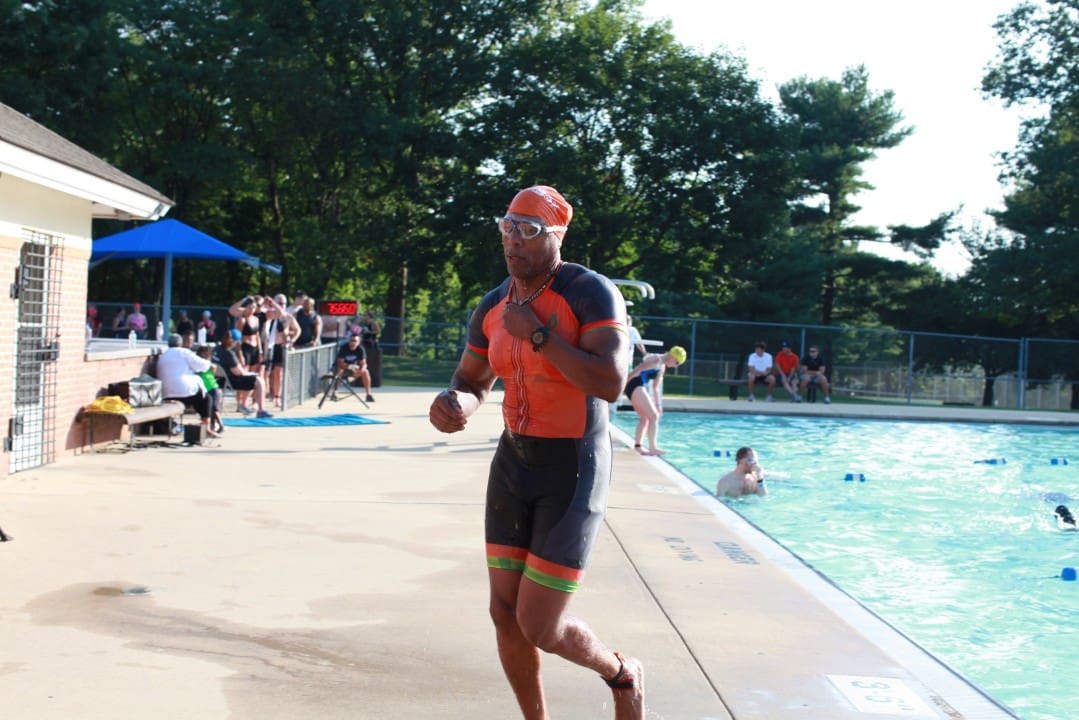There has been a plethora of news reports concerning accidental drownings in either swimming pools or open water. The latest article I read involved a young 25 year old, Tyshon Dye, who reportedly drowned after exhaustion from being too far away from shore. Even a popular TV personality’s sister, age 58, wasn’t able to escape the perils of drowning while fishing in a neighborhood pond. The accident report stated she tripped and no foul play was suspected. Before I could finish this article, a young aspiring basketball phenom and talent, Calistus Anyichie, drowned and was eventually pulled from a gorge in upstate New York. And finally, even the well trained triathletes seemed unable to escape drowning however their situations are most likely due to having a life event (stroke, heart attack or seizure etc) while engaged in the swimming portion of the race. The bottom line is that everyone should be comfortable with swimming and water safety.
At age 53, I am now a seasoned swimmer, master diver and triathlete but I wasn’t always this proficient (I still practice five hours per week). Over the years, being around water and practicing a variety of techniques has made swimming the norm for me. I was traumatized at a very early age due to a family member tossing me and my brother in the deep and left to doggie paddle to safety. Doggie paddle is not a technique, it is a last ditch compromise to survive and is very dangerous to rely on for safety. Being so young made it almost impossible to get a grip on enjoying swimming activities beyond the three foot line or standing on my tippy toes. It took another 20 years to gain confidence and get comfortable enough to take swimming lessons. At age 30, I did something about my childhood dilemma and signed up for an adult swim class. It has paid big dividends as I have maximized opportunities in the aquatic world over the years. I swam in the freezing waters of Antarctica, dived below 80 feet just above where Hammerheads dwell in the Red Sea and explored the teaming aquatic life during a monstrous typhoon off the great barrier reefs of Australia. I have no fear of a 1.5 mile open water swim in the murky lakes in Virginia and Maryland. Yes, I have come a long way. Not everyone has to go to that extreme to swim but I love the open seas and oceans no matter how deep or cold. Sounds like I need my own TV show, right! We’ll I am working on that, trust me.
I hope this article encourages you, the reader, to improve your skills or to sign up for a lesson (s) until you are comfortable swimming beyond 100 meters (at least 2 laps). You will learn enough about buoyancy and water safety to save yourself as well as someone else. Remember, when you enter the water environment, you are potentially impacting the life of those you love and care for you. You also may be putting them at risk in case of your emergency.
Think of swimming this way. Swimming is like a see saw at a playground. You must have your head in the water in order for your heels to be just below the water line. Your hips are the pendulum or core that connect or balance the body and are important for rotation when you need to breathe. The more you turn your body the easier it will be for you to rotate your arms for propulsion. Also, this keeps your legs from separating which you should limit as much as possible. Because the average human head weighs approximately 8 – 10 pounds, you must keep your head and eyes facing down to establish the proper position to move forward. Tuck your chin near your chest and try to relax by breathing evenly. In order to take a breath, you should never raise your head but turn your hips and your mouth will rise above the water line for a quick breath of air next to the front of your shoulder, ahhhhh! Think Head, Hips and Heels. Your arms are your motor, not your feet. If you want to get going, you must move those arms beyond the length of the arm before it. In this case, showing your armpits is perfect form stretching as far as possible like Superman. Remember, 85% of your power comes from your arms. Bottomline, if you have movement, you will remain buoyant. If your head raises up too much, you will drag or sink! Most poor swimmers, swim like a seven (7). Ideally, you want to swim like a straight balanced line so the head and torso must be down in order to keep your hips and heels in a straight line. Your eyeballs should be looking where you want to go. If your head is up gazing at the surroundings, your feet will drop and you will sink and waste precious energy.
If you get tired, flip over on your back and get your chin up and earlobes in the water so that your head is looking back so your heels will always be on top of the water. Wave your wrists and arms in big circles and loosely kick with your feet for buoyancy. This sculling technique will buy you time enough to catch your breath, yell for help and/or give you more time to turn back over and head for safety. Just 10 – 20 seconds of rest will save your life.
Never ever swim alone or beyond your learned capacity or skills.
The idea is to be as long and straight as possible as this will allow you to displace more water and thus remain buoyant. If you have ever noticed a tree log or limb floating in the water, it has perfect buoyancy and this is what you want to accomplish. Tree limbs or branches do not sink because they displace more water and you will too if you are as long as possible. Technically, swimmers should limit the amount of kicking in an effort to reduce fatigue, especially if you find yourself off shore. The more you kick the more you will exhaust yourself. If you are tired after one lap, you are probably kicking way too much!
Finally, you should always wear the proper equipment (goggles, swim cap and fitted swimming gear). BTW, the swim cap is NOT to protect your hair. It is simply an additional level of visible security so the lifeguard and others know where you are so make it as bright as possible in my opinion. Swimming pools are not for playing basketball, volleyball or fighting/running. So if you enjoy other activities in the pool make sure your pool skills come before you start shooting hoops in the pool.
Lets wrap this up in an easy list of quick notes to consider:
- Find and complete a reputable age based swimming course (individual instructor or formal group class).
- Complete a basic water safety course and CPR/AED course. You will need this after there is a swimming accident.
- Never swim alone and always tell/convey to someone of your intentions or whereabouts either verbally or in a written form.
- Always wear the proper equipment before you enter the water.
- Practice, practice, practice, warm up with swim techniques and skills (some courses will provide you drills which you can repeat or increase for proficiency).
- Do not ever rely on flotation devices as a substitute for skills. They are made as a final option for safety not a first option or replacement for proficiency.
- Watch and learn from great swimmers / videos or reading but do not substitute for practice and personal skills. Michael Phelps is a sprinter not a long distance swimmer. His kicks are for short distances and to try to win a medal in the fastest time possible. If he were to swim a mile or two, his kicks would be limited to conserve energy. So remember, kicks are for guidance, buoyancy and direction; not speed or propulsion.
- In an emergency, never try to save another drowning victim as a first option without proper training. First, find a flotation device or rope and try to get it to them. Secondly, find someone who knows how to swim/rescue or yell for assistance. Always keep your eye on the subject and never lose sight of them. Call 911. Assess the situation and always take action. If you try to save a life without these skills, there may be two individuals that need saving. Don’t be the second one!
Swimming is not a color, economic tax status, culture, race or ethnicity; it is a skill that will save your life.
I have enjoyed swimming ever since my first formal swim lesson at age 30. Swimming has honored me on many exhibitions, vacations and ocean swims and it will do the same for you. The earth is approximately 75% surrounded by water so you might as well enjoy as much of the earth as you can.
Remember, fear is a mental mind game, that if not harnessed, will stymie your full potential. Imagined and legacy trauma can be overcome with formal knowledge training and focused practice drills. All adults should know how to swim however it is a personal decision. Much like CPR training, you never know when you will need it to save a life, so please consider getting trained. If you have a fire extinguisher in your home, you should also care enough to learn to swim.
I hope these simple tips will encourage you to make safe swimming a part of your life. If you are a good swimmer, please pass this on to a family member, friend, colleague or young person who may find these notes/tips helpful.
If you have any questions, would like me to speak on this topic or need advice, please do not hesitate to contact me. Always a pleasure to help!

